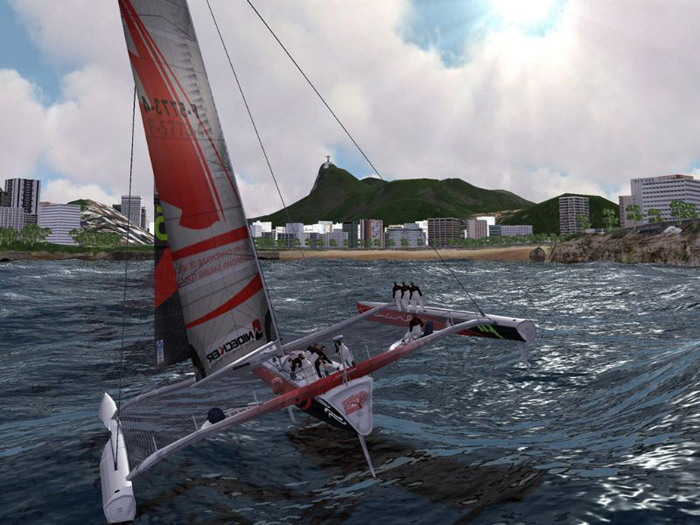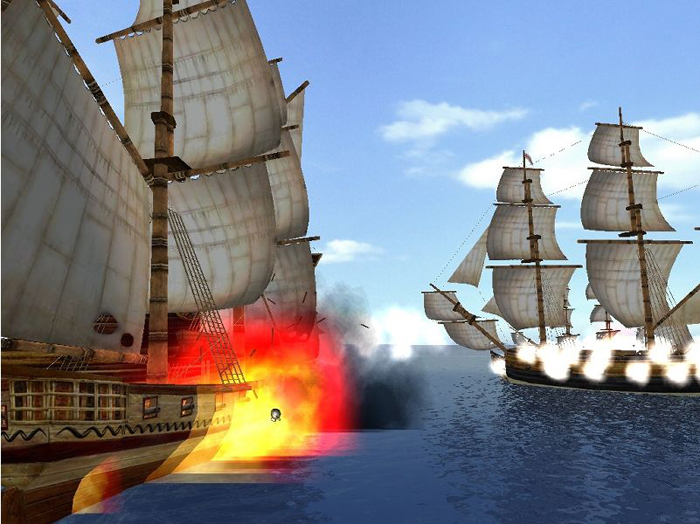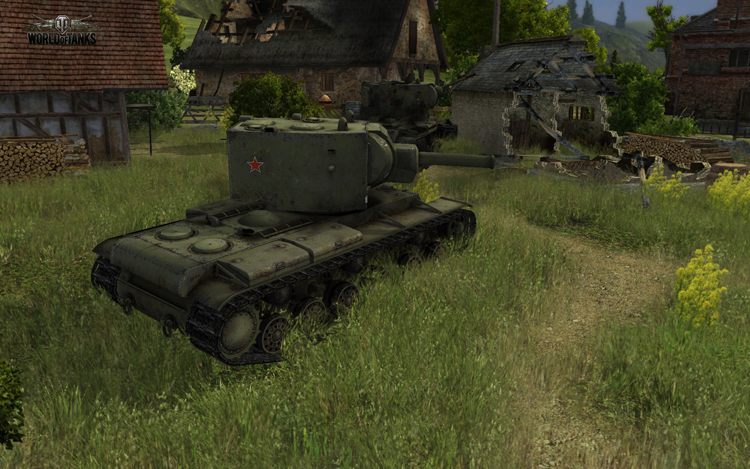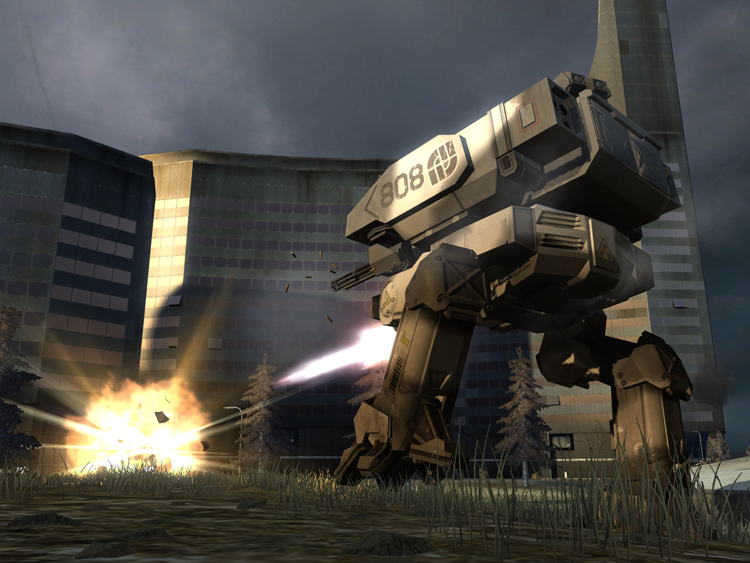Other Vehicles
Flight and driving simulators are by far the most popular kinds, but there are other sorts of vehicle simulators as well, usually for niche markets. The last few years have seen the arrival of large numbers of new vehicles from the hang glider in Far Cry to the magic broomsticks in the Harry Potter games. This section addresses a few of the more common types.
Boats and Ships
Most boat simulations are of powerboats or jet skis, offering the same kinds of speed thrills that driving simulators do (see Figure 3). The handling characteristics of powerboats differ from those of cars. Because boats move in a fluid medium, they don’t have traction the way a car does, so they can’t turn as sharply as a car can. Powerboat simulations usually offer racing over a twisting course marked off by buoys. Jet ski or fantasy water vehicle simulations often have outrageous jumps and other challenges as well.
Figure 3 Jetboat Superchamps in a third-person view. Note the map overlay.
There have been a few simulators of warships over the years, often fairly small craft with high speed and maneuverability, such as the PT boat of World War II fame. Larger vessels such as battleships and aircraft carriers move more slowly and deliberately and, therefore, tend to be simulated not as individual vehicles but as part of naval warfare simulations involving whole fleets, such as Harpoon or Dangerous Waters.
Submarine simulations such as Silent Hunter III are fairly popular because of the specialized nature of their situation and because they can move in three dimensions. They normally concentrate on rather old-fashioned submarine activities, such as looking through the periscope and firing torpedoes at surface ships. We associate these sorts of things with submarines from watching old war movies, and of course, they’re the most visually dramatic. Relatively few games simulate the modern role of submarines, hunting and hiding from one another in total darkness, because it’s too cerebral an activity.
Sailing simulations are comparatively rare, but they do exist; see Virtual Skipper 4 in Figure 4. Although sailing a boat is a complex and interesting challenge, such games appeal only to a specialized market. Most people prefer simulations in which you can point the vehicle in the direction you want to go and push the gas pedal to get you there.
Figure 4 Virtual Skipper 4
Few ship simulations model the ocean in all its complexity, with shoals and currents, tides and storms. Rather, they tend to treat the water the way driving simulations treat the ground: simply as an area over which ships move. Pirate games such as Sea Dogs II (Figure 5) and Sid Meier’s Pirates! are usually arcade or role-playing games rather than sailing simulations.
Figure 5 Sea Dogs II
Tanks and Mechs
Tank simulations seldom implement the complexity of tank battles as they really happened in World War II, the Arab-Israeli wars, or the Gulf War. Real tanks have a top speed of about 50 MPH, have limited visibility, and carry only a few types of weapons, so they don’t appeal much to the casual gamer. Like military flight simulators, tank simulators are typically about a lone tank operating against other tanks and a variety of other enemies.
From a gameplay standpoint, the most interesting characteristic of a tank is its rotating turret, which enables it to shoot in directions other than the one in which it is facing. (Notice the example in Figure 6.) It can be difficult to design a good user interface (UI) for this. You will need to provide a mechanism for rotating the turret that is separate from the mechanism that steers the tank and a separate view window for aiming and firing the gun. Real tanks have a commander and a gun crew as well as a driver, but as with bombers and other multiseat aircraft, you will have to find a way to let a single player control everything.
Figure 6 A tank in World of Tanks. The turret is facing in a different direction from the tracks.
A popular alternative is the mech, which is a science-fiction cousin to the tank that is usually depicted as a large armed and armored walking machine (see Figure 7). Because mechs aren’t restricted by reality, they can carry all sorts of imaginary weapons and hardware, and can be optimized for single-player play.
Figure 7 Battlefield 2142
Spacecraft
There are almost no simulations of real spacecraft—except for quasi-educational ones about the space shuttles—because real spacecraft respond far too slowly and move too deliberately to make for an interesting game. The majority of spacecraft simulations, therefore, are science fiction, and typically they consist of either fighter planes in space, such as the Wing Commander series, or capital ship (large warship) simulations, such as the many Star Trek games. The fighter types are simple action games with only a few variables to manage: fuel, ammunition, damage, shields, and rarely anything else. Capital ship simulations are more strategic, giving the player control of a wide range of weapons and other equipment.





